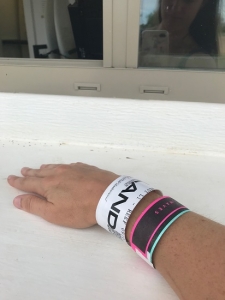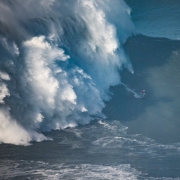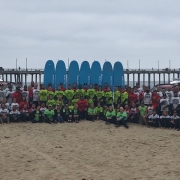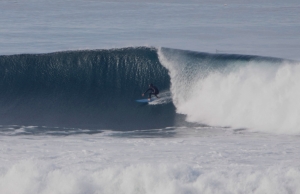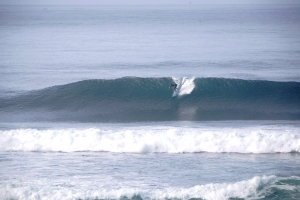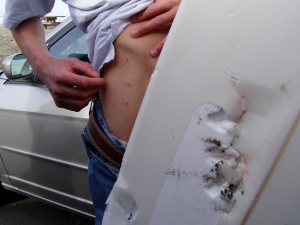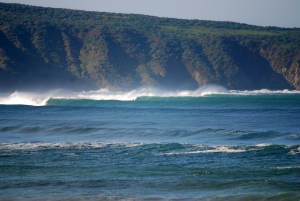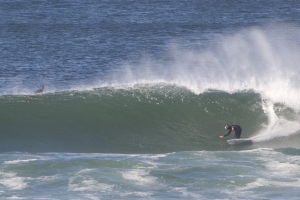Surfing Deep in the Heart of Texas at NLand Surf Park
Just outside of Austin, Texas, sits a giant pool, as large as approximately nine football fields, that is literally a perfect wave machine. Not to be confused with our jargon-ish “inlander” term—NLand Surf Park is the closest any central Texan will get to learning how to surf without paying lofty vacation package prices.
Make an expensive-ass reservation, drive to the boonies, park, sign your life away (waiver), watch the do’s and don’ts video, strap on a ton of wristbands, and pick your stick–if you’re renting.
Pretty sure I wasn’t going to Schlitterbahn…
Visitors have three different wave options, depending on experience level:
1. The Bay
2. The Inside
3. The Reef
If you are learning how to surf, The Bay and a soft top board are your best bets.
If you’re feeling a little more confident and want a step up from the whitewash, The Inside and a soft top board or a longer standard board are good choices for you.
If you are confident in your surfing skills, know how to pop up, drop in and cruise (and want those thighs to burn), The Reef (& the rest of the NLand quiver) are your digs.
Between the serious Texas heat, humidity and thunderstorms popping up on the flat horizon, the water temperature is a balmy 85 degrees and incredibly murky and brown. Think Nicaragua or Costa Rica.
So, absolutely no wetsuit, spring suit or even rashie required.
And to state the obvious: no need to worry about sharks or crocs, this water is fresh, which makes it a bit denser than our beloved ocean water.
Although the park offers a pretty decent quiver, which includes Channel Islands, Russell, Timmy Patterson, etc… if you are very insistent on bringing your own board, bring your floatiest and fattest. In fact, you know that one epoxy board that you got because it was trendy at the time and it’s now collecting dust in the back of your garage because it floats you too much at your local spot?
This is its time to shine.
Dust that puppy off and tote it to kicker country, if your heart so desires.
But, it will cost ya a chunk of change and it’s probably not worth the board bag fee since, well, this is one of the ONLY worthwhile “breaks” around for hundreds of miles, unless you plan to skip off to Central America, OR you have solely dedicated a “surf” trip to Austin–said no one ever.
I was a little nervous to leave my surf fate up to the park’s quiver, but I found their 5’8” epoxy Channel Islands Flyer worked perfectly.
Now for the wave—it’s interesting.
The wave is based on a blade-shaped technology called the wavefoil, which hurtles at a specific speed from one end of the lagoon to the other underneath a “pier” lined by a chain link fence to create a wave that adjusts to the pool bottom’s customized bathymetry, or the water’s depth. When I asked for specific wave heights, the park staff said “8 feet” for the reef, buuut–I think it was more like 6 feet.
Before I even entered the water, the very kind staff reiterated multiple rules, which made smoke come out of my ears.
Can’t I just paddle out and figure it out?
Nope. They said if anything, remember this:
“Paddle out” right by the chain link fence, drop in at a 45 degree angle and make sure you drop in as close to the fence as possible.
Okaaaaay. So, no duck diving?
Nope.
K.
I’m not sure if it was my unusual two cups of coffee or all the rules that were unloaded into my brain, but suddenly, I was nervous. This ain’t the ocean, I’m not paddling out to Trestles. I’m going to ride a man-made wave, how the hell am I more nervous about a man-made wave?! Surely, any break in California would greatly disagree with my odd jitters.
I mean, the reef breaks bigger than what I usually prefer, but, as my grandma always said, que sera sera.
After paddling out, I sat by the marker on the far end of the “pier” for the left-breaking “west reef” wave. Man, why’d I choose backside?!
Suddenly a small roar sounded about 50 feet behind me and the wave appeared out of nowhere. I paddled a few strokes and popped up. Rode it a little bit before I lost the face and succumbed to the whitewash.
Okay cool. I guess I can do this, I thought. I got a few tips from the helpful lifeguards and paddled next to the chain link fence towards the right.
Once the wave jumped into view, I took off and trimmed immediately to the right, where I successfully stayed on the face and rode the wave all the way to the “inside,” kicking out with a boost of air and a canon ball, thighs shaking from the ride.
Yelling out “yew” seemed odd, and so did “yeehaw,” so I settled for “owww!” And paddled back out for another…
Conclusions:
A man-made surf experience helped me appreciate the small things about ocean surfing. Unlike the ‘au naturale,’ wave parks are scheduled/predictable, there’s no aquatic wildlife to observe, the water is, well, warm but ugly, every wave breaks perfectly, and I’m sure if you would consider anyone as a “local…” Maybe the lifeguards?? I certainly didn’t see any 10-gallon hats bobbing around the oddly shaped ‘lineup.’
Even tho this wasn’t ocean surfing, I definitely felt like I was in a better mood once I was done. But that better mood cost me about $200 for two hours.
After leaving high school and Austin for college in California, I once told my friends that if Austin ever builds a wave pool, I will move back. While I’m not exactly eating crow, I did consider it for a New York minute as I do have a soft spot for Texas. But! Living and “surfing” in Austin would be incredibly unsustainable for the amount of time I would need per week. At minimum-with NLand’s pricing, I would require at least two hours for two days on the weekends, which would come to $400 per week, that’s $1,600 a month to surf…hmmm that smells like California rent prices.
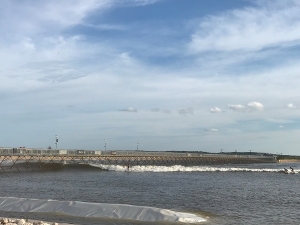
Who can complain about consistent thigh burners? Just bring down the price tag and perhaps I’ll return to being an ‘Austinite.’
Not to mention I would sorely miss the ocean in general and become incredibly bored with the predictability of the same wave day after day, session after expensive-ass session.
Although it’s fun to feel my thighs burn (baby!) and encourage beginner folks to go for the ‘Reef’ wave, I know that for the same $400 or less, I could pop over to Baja and find something similar–cold water temp and possibly sharky, but similar.
Sorry Austinites, breathe a sigh of relief because this California transplant is staying on the west coast.


